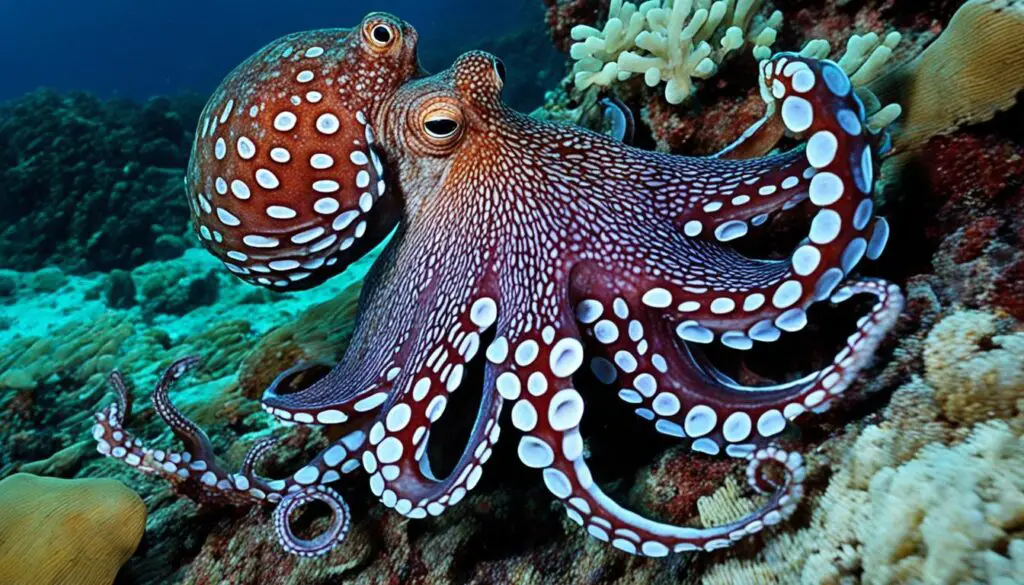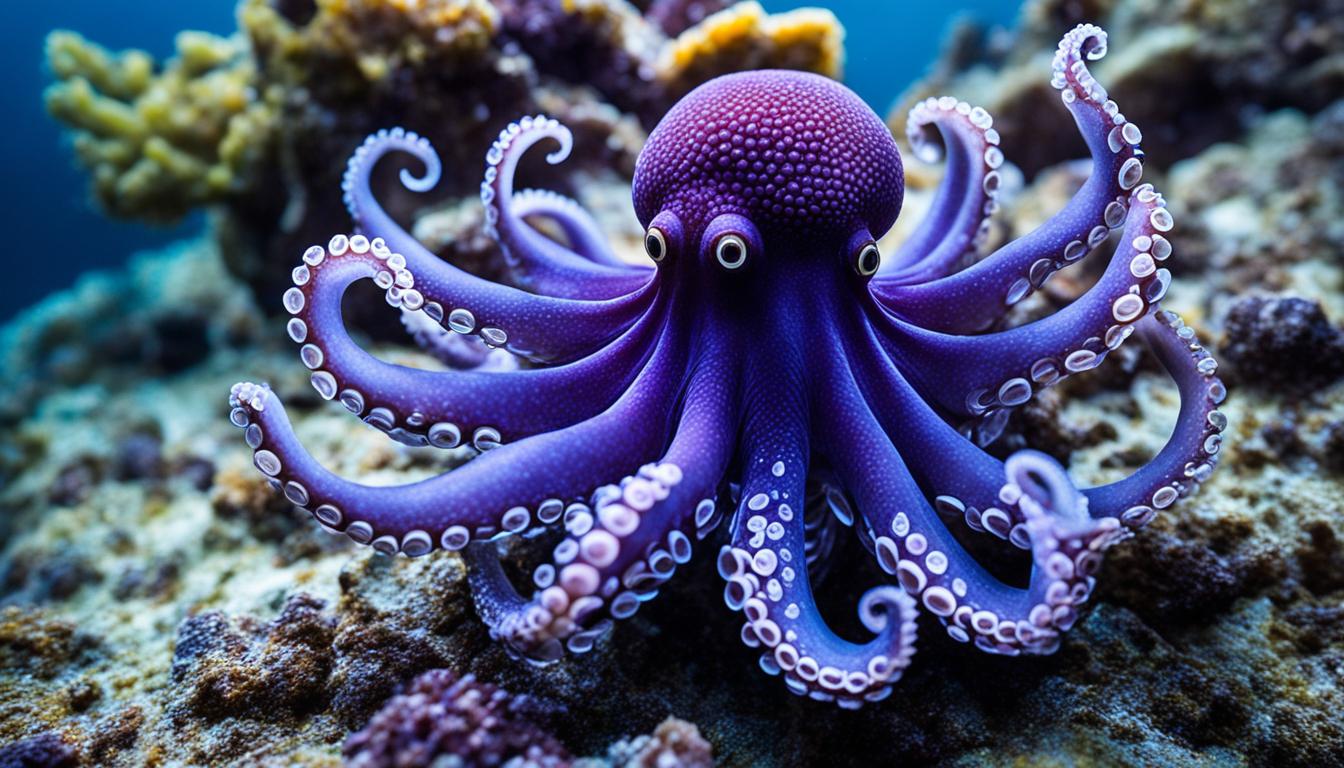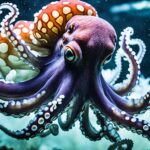When you ask, “How do octopuses move?”, you enter the world of octopus movement. Octopuses are unique in how they move, unlike other sea creatures. They can change how they move easily, whether swimming or crawling on the ocean floor. Their special body structure and brain help them avoid predators and catch prey.
This makes their movement methods fascinating. By learning about their ways, we can see how they’ve adapted to their environment. It also shows how they’ve evolved to survive and thrive in the ocean.
Understanding the Basics of Octopus Locomotion
Octopus locomotion is a fascinating topic that shows how these creatures have evolved. They have a special muscle and nerve setup. This lets them move in ways that are both flexible and controlled.
Octopi are known for their bilateral symmetry. This means they can move their limbs in many directions. Unlike many animals, octopuses can crawl in any direction. They can move smoothly in any direction, keeping their bodies aligned as they go.
These skills are key to their survival. In rocky areas under the sea, octopuses use their agility to avoid predators and move through tight spaces. Their ways of moving also help them with finding food and interacting with others. This makes them ready for many different situations.
| Octopus Locomotion Feature | Description |
|---|---|
| Bilateral Symmetry | Enables flexible movement in various directions. |
| Muscle Structure | Unique muscle combination allows for rapid changes in movement. |
| Locomotion Methods | Includes crawling, jet propulsion, and climbing techniques. |
| Adaptability | Ability to navigate complex environments while evading threats. |
How Do Octopuses Move?
Octopuses move in a fascinating way, thanks to their unique limbs. Their arms are key to how they move around. Each arm can move on its own and is good for different things, like grabbing or climbing.
The Unique Structure of Octopus Limbs
Octopus arms have lots of sensory receptors and muscles for flexibility. With up to 200 muscles in each arm, they can move very precisely. This lets their arms work together or alone, which is important for finding food or exploring.
They can move their arms separately to grab things without disturbing the others. This shows how advanced their biology is.
Muscle Composition and Flexibility
The muscles in an octopus’s arms are key to how it moves. They use different muscle contractions for smooth and strong movements. This helps the octopus move in different ways, like crawling or swimming.
This flexibility is crucial for survival. It helps them escape from predators and catch prey.

| Feature | Description |
|---|---|
| Flexibility | Octopus arms are capable of bending and twisting in various directions due to their unique muscle composition. |
| Independence | Each arm can move independently, allowing for complex tasks like grasping and manipulating objects. |
| Sensory Receptors | Arms contain numerous sensory receptors, enhancing the octopus’s ability to navigate and interact with its surroundings. |
| Muscle Groups | Each arm comprises various muscle groups, enabling both strength for movement and agility for precision tasks. |
Different Movement Methods of Octopuses
Octopuses have amazing ways to move around. They can crawl and swim, which helps them move and survive. This flexibility is key to their success.
Crawling and Climbing Techniques
Octopuses are great at crawling. They use their arms to grip surfaces and pull themselves forward. This lets them move quickly over the ocean floor.
They can climb through rocks and grasp objects with ease. This shows how smart and flexible they are.
Swimming and Propulsion Methods
Octopuses swim fast and smoothly. They use jet propulsion to push water out of their body. This makes them move quickly when they need to escape.
Each type of octopus swims differently, based on where they live. Their swimming skills help them survive in many ocean places.
| Movement Method | Description | Advantages |
|---|---|---|
| Octopus Crawling | Utilizing limbs to grip and pull the body forward. | Efficient navigation in complex environments; effective in stealthy approaches. |
| Jet Propulsion | Expelling water for quick bursts of speed. | Rapid escapes from threats; agile swimming in open water. |
The Role of the Nervous System in Movement
The octopus is a remarkable creature, known for its unique nervous system. This system helps it move in complex ways. Its nervous system is set up to control its limbs in a special way. This setup helps with octopus motor coordination, making it move well in different places.
Decentralized Control and Motor Coordination
Each octopus arm works on its own, showing quick control over its actions. This lets octopuses do precise tasks, like opening shells or moving through small spaces. Their ability to move this way shows how advanced their octopus control systems are, unlike other animals.
Embodied Organization and Motion Command Centers
Studies now show that octopuses have special centers in their nervous system for moving. These centers help mix sensory information with motor actions. This lets octopuses do complex moves. The idea of embodied organization shows how these animals develop their octopus motor coordination and survival skills.
Octopus Swimming Techniques and Patterns
Octopuses swim using a special way called jet propulsion. They push water out of their body to move fast. This lets them quickly change direction with their flexible arms. This skill helps them avoid predators or catch prey fast.
Jet Propulsion Explained
Octopuses use a smart way to swim called propulsion. By pushing water out, they move forward quickly. Their flexible body lets them control their swimming power and direction. This makes them fast and agile in the water.
Passive and Active Swimming Behaviors
Octopuses also swim passively and actively. They use their natural buoyancy to float through the water easily. But when they swim actively, they control their movement to hunt or explore. This mix of swimming styles shows how versatile they are and helps them survive in the ocean.
FAQ
How do octopuses move?
What are the primary movement methods used by octopuses?
How do octopus limbs contribute to their movement capabilities?
What role does the octopus nervous system play in locomotion?
Can you explain jet propulsion in octopuses?
What are passive and active swimming behaviors in octopuses?
How do octopuses adapt their movement methods to different environments?
Source Links
- https://www.nhm.ac.uk/discover/octopuses-keep-surprising-us-here-are-eight-examples-how.html
- https://www.sciencenews.org/article/octopuses-move-uncoordinated-arms
- https://oxfordre.com/neuroscience/display/10.1093/acrefore/9780190264086.001.0001/acrefore-9780190264086-e-283?p=emailAQpShWNl9DQM2&d=/10.1093/acrefore/9780190264086.001.0001/acrefore-9780190264086-e-283










